Analysis of the Spatial Pattern of Urban Expansion in African Countries Under Different Shared Socioeconomic Pathway (SSP) Scenarios
Abstract
1. Introduction
2. Materials and Methods
2.1. Study Area
2.2. Data Sources
2.3. Shared Socioeconomic Scenarios (SSPs)
2.4. Prediction Model of Urban Land Area in Africa
2.5. FLUS Model
2.6. African Urban Expansion Indicators
3. Results
3.1. Change of Urban Land Area in African Countries Under the SSPs Scenario
3.2. Spatial Distribution of Future Urban Land Use in African Countries Under the SSP Scenario
3.3. Expansion Characteristics of Cities in African Countries Under Different SSP Scenarios
4. Discussion
4.1. Comparative Analysis of Urban Land Growth in African Countries Under Different SSP Scenarios
4.2. Comparison of This Study with the Studies in Other Regions
4.3. Model Limitations and the Direction of Improvement
4.4. Relevant Policy Recommendations
5. Conclusions
Author Contributions
Funding
Data Availability Statement
Conflicts of Interest
References
- Angel, S.; Parent, J.; Civco, D.L.; Blei, A.M. Making Room for a Planet of Cities; Lincoln Institute of Land Policy: Cambridge, MA, USA, 2011. [Google Scholar]
- Brenner, N.; Schmid, C. Towards a New Epistemology of the Urban. City 2014, 18, 151–182. [Google Scholar] [CrossRef]
- Grimm, N.B.; Faeth, S.H.; Golubiewski, N.E.; Redman, C.L.; Wu, J.; Bai, X.; Briggs, J.M. Global Change and the Ecology of Cities. Science 2008, 319, 756–760. [Google Scholar] [CrossRef] [PubMed]
- Batty, M. The New Science of Cities; MIT Press: Cambridge, MA, USA, 2013. [Google Scholar]
- Knaap, G.J.; Hopkins, L.D. The inventory approach to urban growth boundaries. J. Am. Plan. Assoc. 2001, 67, 314–326. [Google Scholar] [CrossRef]
- Hall, P.; Pfeiffer, U. Urbanization in Europe 1950–2000: An overview. GeoJournal 2008, 71, 1–14. [Google Scholar]
- Xu, X.; Du, Z.; Zhang, H. Integrating the System Dynamic and Cellular Automata Models to Predict Land Use and Land Cover Change. Int. J. Appl. Earth Obs. Geoinf. 2016, 52, 568–579. [Google Scholar] [CrossRef]
- Chaudhuri, G.; Clarke, K. The SLEUTH land use change model: A review. Environ. Resour. Res. 2013, 1, 88–105. [Google Scholar]
- Luo, H.; Li, Y.; Gao, X.; Meng, X.; Yang, X.; Yan, J. Carbon Emission Prediction Model of Prefecture-Level Administrative Region: A Land-Use-Based Case Study of Xi’an City, China. Appl. Energy 2023, 348, 121488. [Google Scholar] [CrossRef]
- Li, X.; Liu, Z.; Li, S.; Li, Y.; Wang, W. Urban land carbon emission and carbon emission intensity prediction based on patch-generating land use simulation model and grid with multiple scenarios in Tianjin. Land 2023, 12, 2160. [Google Scholar] [CrossRef]
- Jiang, L.; O’Neill, B.C. Global Urbanization Projections for the Shared Socioeconomic Pathways. Glob. Environ. Change 2017, 42, 193–199. [Google Scholar] [CrossRef]
- Karutz, R.; Klassert CJ, A.; Kabisch, S. On farmland and floodplains—Modeling urban growth impacts based on global population scenarios in Pune, India. Land 2023, 12, 1051. [Google Scholar] [CrossRef]
- Kantakumar, L.N.; Kumar, S.; Schneider, K. What Drives Urban Growth in Pune? A Logistic Regression and Relative Importance Analysis Perspective. Sustain. Cities Soc. 2020, 60, 102269. [Google Scholar] [CrossRef]
- Gibson, J.; Boe-Gibson, G.; Stichbury, G. Urban Land Expansion in India 1992–2012. Food Policy 2015, 56, 100–113. [Google Scholar] [CrossRef]
- Liu, Y.; Liu, X.; Chen, Y.; Long, H. Land use transitions in China: Insights from the integrated analysis of satellite remote sensing data. J. Clean. Prod. 2020, 262, 121273. [Google Scholar]
- Tian, L.; Qiao, X. Spatial-temporal evolution and influencing factors of urban land expansion in China: Based on the geographical weighted regression model. Habitat Int. 2018, 74, 1–10. [Google Scholar] [CrossRef]
- Datta, A. Urbanization and economic development in India. J. Asian Econ. 2012, 23, 237–245. [Google Scholar]
- Sivaramakrishnan, K.C.; Kundu, A. Urbanization and urban governance in India. Econ. Political Wkly. 2004, 39, 4545–4552. [Google Scholar]
- Satterthwaite, D. Sustainable Cities or Cities that Contribute to Sustainable Development? In The Earthscan Reader in Sustainable Cities; Routledge: London, UK, 2021; pp. 80–106. [Google Scholar]
- Fujii, S.; Managi, S. Land use change and its impacts on ecosystem services in Japan. Ecol. Econ. 2016, 127, 241–249. [Google Scholar]
- Jantz, C.A.; Goetz, S.J.; Shelley, M.K. Using the SLEUTH Urban Growth Model to Simulate the Impacts of Future Policy Scenarios on Urban Land Use in the Baltimore-Washington Metropolitan Area. Environ. Plan. B Plan. Des. 2004, 31, 251–271. [Google Scholar] [CrossRef]
- Liu, Y.; Wang, L.; Long, H. Spatio-temporal analysis of land-use conversion in the eastern coastal China during 1996–2005. J. Geogr. Sci. 2008, 18, 274–282. [Google Scholar] [CrossRef]
- Seto, K.C.; Reenberg, A.; Boone, C.G.; Fragkias, M.; Haase, D.; Langanke, T.; Marcotullio, P.; Munroe, D.K.; Olah, B.; Simon, D. Urban land teleconnections and sustainability. Proc. Natl. Acad. Sci. USA 2012, 109, 7687–7692. [Google Scholar] [CrossRef]
- Gidey, E.; Dikinya, O.; Sebego, R.; Segosebe, E.; Zenebe, A. Cellular automata and Markov Chain (CA_Markov) model-based predictions of future land use and land cover scenarios (2015–2033) in Raya, northern Ethiopia. Model. Earth Syst. Environ. 2017, 3, 1245–1262. [Google Scholar] [CrossRef]
- Seto, K.C.; Güneralp, B.; Hutyra, L.R. Global forecasts of urban expansion to 2030 and direct impacts on biodiversity and carbon pools. Proc. Natl. Acad. Sci. USA 2012, 109, 16083–16088. [Google Scholar] [CrossRef] [PubMed]
- Popp, A.; Calvin, K.; Fujimori, S.; Havlik, P.; Humpenöder, F.; Stehfest, E.; Bodirsky, B.L.; Dietrich, J.P.; Doelmann, J.C.; Gusti, M.; et al. Land use futures in the shared socio-economic pathways. Glob. Environ. Change 2017, 42, 331–345. [Google Scholar] [CrossRef]
- Fricko, O.; Havlik, P.; Rogelj, J.; Klimont, Z.; Gusti, M.; Johnson, N.; Kolp, P.; Strubegger, M.; Valin, H.; Amann, M.; et al. The marker quantification of the shared socioeconomic pathway 2: A middle-of-the-road scenario for the 21st century. Glob. Environ. Change 2017, 42, 251–267. [Google Scholar] [CrossRef]
- O’Neill, B.C.; Kriegler, E.; Riahi, K.; Ebi, K.L.; Hallegatte, S.; Carter, T.R.; Mathur, R.; van Vuuren, D.P. A new scenario framework for climate change research: The concept of shared socioeconomic pathways. Clim. Change 2014, 122, 387–400. [Google Scholar] [CrossRef]
- Bian, R.; Zhao, A.; Zou, L.; Liu, X.; Xu, R.; Li, Z. Simulation and Prediction of Land Use Change and Carbon Emission under Multiple Development Scenarios at the City Level: A Case Study of Xi’an, China. Land 2024, 13, 1079. [Google Scholar] [CrossRef]
- Potapov, P.V.; Turubanova, S.A.; Hansen, M.C.; Adusei, B.; Broich, M.; Altstatt, A.; Mane, L.; Justice, C.O. Quantifying forest cover loss in Democratic Republic of the Congo, 2000–2010, with Landsat ETM+ data. Remote Sens. Environ. 2012, 122, 106–116. [Google Scholar] [CrossRef]
- Verburg, P.H.; Soepboer, W.; Veldkamp, A.; Limpiada, R.; Espaldon VO, L.; Sharifa, M.A. Modeling the spatial dynamics of regional land use: The CLUE-S model. Environ. Manag. 2002, 30, 391–405. [Google Scholar] [CrossRef]
- Brown, D.G.; Johnson, K.M.; Loveland, T.R.; Theobald, D.M. Rural land-use trends in the conterminous United States, 1950–2000. Ecol. Appl. 2005, 15, 1851–1863. [Google Scholar] [CrossRef]
- Liu, X.; Li, X. Assessing the impact of urbanization on ecosystem services using land use change scenarios. J. Environ. Manag. 2018, 206, 1122–1132. [Google Scholar]
- Gao, Y.; Jiao, L.; Wang, W. Analysis of the spatial pattern of urban expansion in countries along the Belt and Road under the shared social and economic situation. Geogr. Geogr. Inf. Sci. 2023, 6, 36–44. [Google Scholar] [CrossRef]
- Elvidge, C.D.; Baugh, K.E.; Kihn, E.A.; Kroehl, H.W.; Davis, E.R. Mapping city lights with nighttime data from the DMSP operational linescan system. Photogramm. Eng. Remote Sens. 1997, 63, 727–734. [Google Scholar]
- Peng, K.; Jiang, W.; Deng, Y. Simulating urban land-use changes by incorporating logistic regression and CLUE-S model: A case study of Wuhan city. In Proceedings of the 2021 28th International Conference on Geoinformatics, Nanchang, China, 3–5 November 2021; IEEE: Piscataway, NJ, USA, 2021; pp. 1–5. [Google Scholar]
- Van Vuuren, D.P.; Stehfest, E.; Gernaat, D.E.; Doelman, J.C.; van den Berg, M.; Harmsen, M.; De Boer, H.S.; Bouwman, L.F.; Daioglou, V.; Edelenbosch, O.Y.; et al. Energy, land—Use and greenhouse gas emissions trajectories under a green growth paradigm. Glob. Environ. Change 2017, 42, 237–250. [Google Scholar] [CrossRef]
- Fujimori, S.; Hasegawa, T.; Masui, T.; Takahashi, K.; Herran, D.S.; Dai, H.; Hijioka, Y.; Kainuma, M. SSP3: AIM implementation of shared socioeconomic pathways. Glob. Environ. Change 2017, 42, 268–283. [Google Scholar] [CrossRef]
- Calvin, K.; Bond-Lamberty, B.; Clarke, L.; Edmonds, J.; Eom, J.; Hartin, C.; Kim, S.; Kyle, P.; Link, R.; Moss, R.; et al. The SSP4: A world of deepening inequality. Glob. Environ. Change 2017, 42, 284–296. [Google Scholar] [CrossRef]
- Kriegler, E.; Bauer, N.; Popp, A.; Humpenöder, F.; Leimbach, M.; Strefler, J.; Baumstark, L.; Bodirsky, B.L.; Hilaire, J.; Klein, D.; et al. Fossil-Fueled development (SSP5): An energy and resource intensive scenario for the 21st century. Glob. Environ. Change 2017, 42, 297–315. [Google Scholar] [CrossRef]
- Hu, J.; Liu, D.; Zheng, X. Research on Multi-Scenario Simulation of Urban Expansion for Beijing–Tianjin–Hebei Region Considering Multilevel Urban Flows. Land 2024, 13, 1830. [Google Scholar] [CrossRef]
- Sun, Y.; Liu, D.; Wang, P. Urban Simulation Incorporating Coordination Relationships of Multiple Ecosystem Services. Sustain. Cities Soc. 2022, 76, 103432. [Google Scholar] [CrossRef]
- Li, H.; Liu, Y.; He, Q.; Peng, X.; Yin, C. Simulating Urban Cooperative Expansion in a Single-Core Metropolitan Region Based on Improved CA Model Integrated Information Flow: Case Study of Wuhan Urban Agglomeration in China. J. Urban Plan. Dev. 2018, 144, 05018002. [Google Scholar] [CrossRef]
- Cramer, C.; Sender, J.; Oqubay, A. African Economic Development: Evidence, Theory, Policy; Oxford University Press: Oxford, UK, 2020. [Google Scholar]
- Obi-Ani, N.A.; Isiani, M.C. Urbanization in Nigeria: The Onitsha experience. Cities 2020, 104, 102744. [Google Scholar] [CrossRef]
- Adewuyi, A.O.; Ayoola, O.B. Internal Migration in Nigeria: Positive Contributions to Human Development. J. Niger. Stud. 2018, 16, 123–140. [Google Scholar]
- Omonigho, T. Okhankhuele, Olaniyan Z. Opafunso. Causes and Consequences of Rural-Urban Migration Nigeria: A Case Study of Ogun Waterside Local Government Area of Ogun State, Nigeria. Br. J. Arts Soc. Sci. 2025, 16, 185–194. [Google Scholar]
- Ologeh, I.O.; Akarakiri, J.B.; Sobanke, V.O. Assessment of Climate Change-Induced Migration of Crop Farmers in Northern Nigeria. In Handbook of Climate Change Management: Research, Leadership, Transformation; Springer International Publishing: Cham, Switzerland, 2020; pp. 1–17. [Google Scholar]
- Kassouri, Y.; Okunlola, O.A. Analysis of spatio-temporal drivers and convergence characteristics of urban development in Africa. Land Use Policy 2021, 109, 105868. [Google Scholar] [CrossRef]
- Pender, J.; Gebremedhin, B.; Benin, S.; Ehui, S. Strategies for sustainable agricultural development in the Ethiopian highlands. Am. J. Agric. Econ. 2001, 83, 1231–1240. [Google Scholar] [CrossRef]
- Collier, P.; Venables, A.J. Urban infrastructure for development. Oxf. Rev. Econ. Policy 2016, 32, 391–409. [Google Scholar] [CrossRef]
- Zhao, S.; Qi, J.; Li, D.; Wang, X. Land use change and its influencing factors along railways in Africa: A case study of the Ethiopian section of the Addis Ababa–Djibouti Railway. J. Geogr. Sci. 2024, 34, 1128–1156. [Google Scholar] [CrossRef]
- Weltbank. Ethiopia-Toward the Competitive Frontier: Strategies for Improving Ethiopia’s Investment Climate; World Bank: Washington, DC, USA, 2012. [Google Scholar]
- Li, X.; Zhou, W.; Ouyang, Z. Forty years of urban expansion in Beijing: What is the relative importance of physical, socioeconomic, and neighborhood factors? Appl. Geogr. 2013, 38, 1–10. [Google Scholar] [CrossRef]
- Angel, S.; Parent, J.; Civco, D.L.; Blei, A.M.; Potere, D. The dimensions of global urban expansion: Estimates and projections for all countries, 2000–2050. Prog. Plan. 2011, 75, 53–107. [Google Scholar] [CrossRef]
- Pienaar, S.M.; Ndlovu, T. Land Use Policy Changes in South Africa for Managing Urban Growth and Protecting Agricultural and Ecological Land. Land Use Policy 2023, 128, 106585. [Google Scholar]
- Aribigbola, A. Urban Land Use Planning, Policies and Management in Sub-Saharan African Countries: Empirical Evidence from Akure, Nigeria. Urban Forum 2007, 18, 137–153. [Google Scholar]
- Goodness, C.A. Effects of Fiscal and Monetary Policy Uncertainty on Economic Activity in South Africa. Adv. Decis. Sci. 2021, 25, 1–18. [Google Scholar]
- Cobbinah, P.B.; Finn, B.M. Planning and Climate Change in African Cities: Informal Urbanization and ‘Just’ Urban Transformations. J. Plan. Lit. 2023, 38, 361–379. [Google Scholar] [CrossRef]
- Adhikari, S.; Koirala, P.; Ghosh, A.; Henry, M. Planning for Sustainable Cities in Africa: Experiences, Challenges and Prospects of Monitoring Geospatial Indicators. Remote Sens. 2022, 14, 2821. [Google Scholar] [CrossRef]
- Ouedraogo, V.; Hackman, K.O.; Thiel, M.; Dukiya, J. Intensity Analysis for Urban Land Use/Land Cover Dynamics Characterization of Ouagadougou and Bobo-Dioulasso in Burkina Faso. Land 2023, 12, 1063. [Google Scholar] [CrossRef]
- Loulad, S.; Nguyen, T.T.; Simou, M.R.; Rhinane, H.; Buerkert, A. Monitoring rural-urban transformation in the coastal region of Rabat-Sale-Kenitra, Morocco. PLoS ONE 2023, 18, e0290829. [Google Scholar] [CrossRef]
- Berriane, M.; de Haas, H.; Natter, K. Social Transformations and Migrations in Morocco. 2021. Available online: https://hdl.handle.net/1887/3239103 (accessed on 20 February 2025).
- Assede, E.S.; Orou, H.; Biaou, S.S.; Geldenhuys, C.J.; Ahononga, F.C.; Chirwa, P.W. Understanding drivers of land use and land cover change in Africa: A review. Curr. Landsc. Ecol. Rep. 2023, 8, 62–72. [Google Scholar] [CrossRef]
- Muinzer, T.L.; Mackie, C. The Sustainable Development Goals. In Energy Law and the Sustainable Development Goals; Routledge: London, UK, 2024; pp. 15–25. [Google Scholar]
- Wei, G.; He, B.-J.; Sun, P.; Liu, Y.; Li, R.; Ouyang, X.; Luo, K.; Li, S. Evolutionary trends of urban expansion and its sustainable development: Evidence from 80 representative cities in the belt and road initiative region. Cities 2023, 138, 104353. [Google Scholar] [CrossRef]
- Rogerson, C.M. Small-scale manufacturing in South Africa’s economic heartland: Problems and future prospects. In Urban Forum; Leiden University Catalogue: Dordrecht, The Netherlands, 1998; Volume 9, pp. 279–300. [Google Scholar]
- Lewis, J.D. Policies to Promote Growth and Employment in South Africa; World Bank, Southern Africa Department: Tshwane, South Africa, 2001; Volume 16. [Google Scholar]
- Makhathini, M.S.; Mlambo, V.H.; Mpanza, S. Infrastructure provision as a catalyst for local economic development in South Africa. Strateg. Rev. S. Afr. 2020, 42. [Google Scholar] [CrossRef]
- Liu, Z.; Huang, J.; Wang, R.; Zhou, C.; Lu, L. Urban expansion monitoring in South Asia based on SPOT/VGT and DMSP/OLS data. In Proceedings of the 2017 2nd International Conference on Image, Vision and Computing (ICIVC), Chengdu, China, 2–4 June 2017; IEEE: Piscataway, NJ, USA; pp. 1142–1146. [Google Scholar]
- Raihan, A.; Ibrahim, S.; Muhtasim, D.A. Dynamic impacts of economic growth, energy use, tourism, and agricultural productivity on carbon dioxide emissions in Egypt. World Dev. Sustain. 2023, 2, 100059. [Google Scholar] [CrossRef]
- Amadou, O. The Effects of Economic Globalization on Developing States: The Case of The Republic of Benin (2016–2021). Bölge Çalışmaları Derg. 2023, 2, 70–82. [Google Scholar]
- Zinkina, J.; Korotayev, A. Urbanization dynamics in Egypt: Factors, trends, perspectives. Arab Stud. Q. 2013, 35, 20–38. [Google Scholar] [CrossRef]
- Nkeki, F.N. Spatio-temporal analysis of land use transition and urban growth characterization in Benin metropolitan region, Nigeria. Remote Sens. Appl. Soc. Environ. 2016, 4, 119–137. [Google Scholar] [CrossRef]
- Dorling, D. World population prospects at the UN: Our numbers are not our problem? In The Struggle for Social Sustainability; Policy Press: Bristol, UK, 2021; pp. 129–154. [Google Scholar]
- Allen, C.; Nejdawi, R.; El-Baba, J.; Hamati, K.; Metternicht, G.; Wiedmann, T. Indicator-based assessments of progress towards the sustainable development goals (SDGs): A case study of the Arab region. Sustain. Sci. 2017, 12, 975–989. [Google Scholar] [CrossRef]
- Tiando, D.S.; Hu, S.; Fan, X.; Ali, M.R. Tropical coastal land-use and land cover changes impact on ecosystem service value during rapid urbanization of Benin, West Africa. Int. J. Environ. Res. Public Health 2021, 18, 7416. [Google Scholar] [CrossRef]
- Change, O.C. Intergovernmental panel on climate change. World Meteorol. Organ. 2007, 52, 1. [Google Scholar]
- Kikstra, J.S.; Nicholls, Z.R.J.; Smith, C.J.; Lewis, J.; Lamboll, R.D.; Byers, E.; Sandstad, M.; Meinshausen, M.; Gidden, M.J.; Rogelj, J.; et al. The IPCC Sixth Assessment Report WGIII climate assessment of mitigation pathways: From emissions to global temperatures. Geosci. Model Dev. 2022, 15, 9075–9109. [Google Scholar] [CrossRef]
- Badi, I.; Stević, Ž.; Bouraima, M.B. Overcoming obstacles to renewable energy development in Libya: An MCDM approach towards effective strategy formulation. Decis. Mak. Adv. 2023, 1, 17–24. [Google Scholar] [CrossRef]
- Strangio, D. Analysis of the Economic System of Somalia. In The Reasons for Underdevelopment. Contributions to Economics; Springer: Cham, Switzerland, 2012; pp. 39–74. [Google Scholar] [CrossRef]
- Irhiam, H.; Schaeffer, M.; Watanabe, K. (Eds.) The Long Road to Inclusive Institutions in Libya: A Sourcebook of Challenges and Needs; World Bank Publications: Washington, DC, USA, 2023. [Google Scholar]
- Statista. Population Growth in Somalia 2013–2023. 22 November 2024. Available online: https://www.statista.com/statistics/452246/population-growth-in-somalia/ (accessed on 22 November 2024).
- Aamir, M.; ur Rehman, J. Dynamic nexus among fossil fuels utilization, economic growth, and urbanization: A tri-regional selected countries analysis. Environ. Sci. Pollut. Res. 2024, 31, 43381–43395. [Google Scholar] [CrossRef]
- Le Sage, A.; Majid, N. The livelihoods gap: Responding to the economic dynamics of vulnerability in Somalia. Disasters 2002, 26, 10–27. [Google Scholar] [CrossRef]
- Ologunde, O.H.; Kelani, M.O.; Biru, M.K.; Olayemi, A.B.; Nunes, M.R. Land Use and Land Cover Changes: A Case Study in Nigeria. Land 2025, 14, 389. [Google Scholar] [CrossRef]
- Bloch, R.; Fox, S.; Monroy, J.; Ojo, A. Urbanisation and Urban Expansion in Nigeria; Urbanisation Research Nigeria (URN) Research Report; ICF International: London, UK, 2015. [Google Scholar]
- Xu, J.; Wang, X. Reversing Uncontrolled and Unprofitable Urban Expansion in Africa through Special Economic Zones: An Evaluation of Ethiopian and Zambian Cases. Sustainability 2020, 12, 9246. [Google Scholar] [CrossRef]
- Kaluwa, B. Industrial development in sub-Saharan Africa: The impact of structural adjustment. In Structural Adjustment, Reconstruction and Development in Africa; Routledge: London, UK, 2019; pp. 71–81. [Google Scholar]
- Chamberlin, J.; Jayne, T.S.; Headey, D. Scarcity amid plenty? Reassessing the potential for cropland expansion in Africa. Food Policy 2014. [Google Scholar] [CrossRef]
- Jiang, S.; Zhang, Z.; Ren, H. Spatiotemporal characteristics of urban land expansion and population growth in Africa from 2001 to 2019: Evidence from population density data. ISPRS Int. J. Geo Inf. 2021, 10, 584. [Google Scholar] [CrossRef]
- Kamaldeen, Y.; Eric, B.D.; Alexandros, G. Sustainability of urban expansion in Africa: A systematic literature review using the Drivers–Pressures–State–Impact–Responses (DPSIR) framework. Sustain. Sci. 2023, 18, 1459–1479. [Google Scholar]
- Iyakaremye, V.; Zeng, G.; Yang, X. In 21st century mid-century increased high temperature extremes and associated population exposure in Africa. Sci. Total Environ. 2021, 790, 148162. [Google Scholar] [CrossRef]
- Owoeye, J.O. Assessing Urban Growth Dynamics and Depletion of Agricultural Land Use in Akure Region, Nigeria. Land Sci. 2019, 1, 43. [Google Scholar] [CrossRef]
- Adzandeh, E.A.; Alaigba, D.; Nkemasong, C.N. Application of Geospatial Techniques and Logistic Regression Model for Urban Growth Analysis in Limbe, Cameroon. Niger. J. Environ. Sci. Technol. (NIJEST) 2020, 4, 138–151. [Google Scholar] [CrossRef]
- Xu, G.; Dong, T.; Cobbinah, P.B.; Jiao, L.; Sumari, N.S.; Chai, B.; Liu, Y. Urban expansion and form changes across African cities with a global outlook:Spatiotemporal analysis of urban land densities. J. Clean. Prod. 2019, 224, 802–810. [Google Scholar] [CrossRef]
- Enuoh, R. Business ethics and the Nigerian oil industry:a study of the niger delta. Int. J. Res. Innov. Soc. Sci. (IJRISS) 2019, 9, 285–293. [Google Scholar]
- Abo El Wafa Moustafa, H. Spatial Scenario Modelling for the Sustainable Planning of Urbanising Regions in Sub-Saharan African Cities. Doctoral Dissertation, Technische Universität Munich, Munich, Germany, 2019. [Google Scholar]
- Hashidu, B.R.; Abbas, A.M.; Kamaludeen, A.M. Urban growth pattern and agricultural land use dynamics in Gombe City, Nigeria. J. Adv. Res. Agric. Sci. Technol. 2019, 2, 43–49. [Google Scholar]
- Tadjie, R. Expansion urbaine et acuité des problèmes fonciers au Cameroun. RiA Recht Afr. Law Afr. Droit En Afr. 2018, 20, 171–191. [Google Scholar] [CrossRef]
- Chen, G.; Li, X.; Liu, X.; Chen, Y.; Liang, X.; Leng, J.; Xu, X.; Liao, W.; Qiu, Y.; Wu, Q. A global urban land expansion product at 1-km resolution for 2015 to 2100 based on the SSP scenarios. PANGAEA 2019. [Google Scholar] [CrossRef]
- Angel, S.; Blei, A.M. Atlas of Urban Expansion; Lincoln Institute of Land Policy: Cambridge, MA, USA, 2012. [Google Scholar]
- Liu, X.; Li, X.; Liu, L.; He, J.; Ai, B. A bottom-up approach to discover transition rules of cellular automata using ant intelligence. Int. J. Geogr. Inf. Sci. 2017, 22, 1247–1269. [Google Scholar] [CrossRef]
- Merkle, M.; Alexander, P.; Brown, C.; Seo, B.; Harrison, P.A.; Harmáčková, Z.V.; Pedde, S.; Rounsevell, M. Downscaling population and urban land use for socio-economic scenarios in the UK. Reg. Environ. Change 2022, 22, 106. [Google Scholar] [CrossRef]
- Jing, C.; Tao, H.; Jiang, T.; Wang, Y.; Zhai, J.; Cao, L.; Su, B. Population, urbanization and economic scenarios over the Belt and Road region under the Shared Socioeconomic Pathways. J. Geogr. Sci. 2020, 30, 68–84. [Google Scholar] [CrossRef]
- Reimann, L.; Merkens, J.L.; Vafeidis, A.T. Regionalized Shared Socioeconomic Pathways: Narratives and spatial population projections for the Mediterranean coastal zone. Reg. Environ. Change 2018, 18, 235–245. [Google Scholar] [CrossRef]
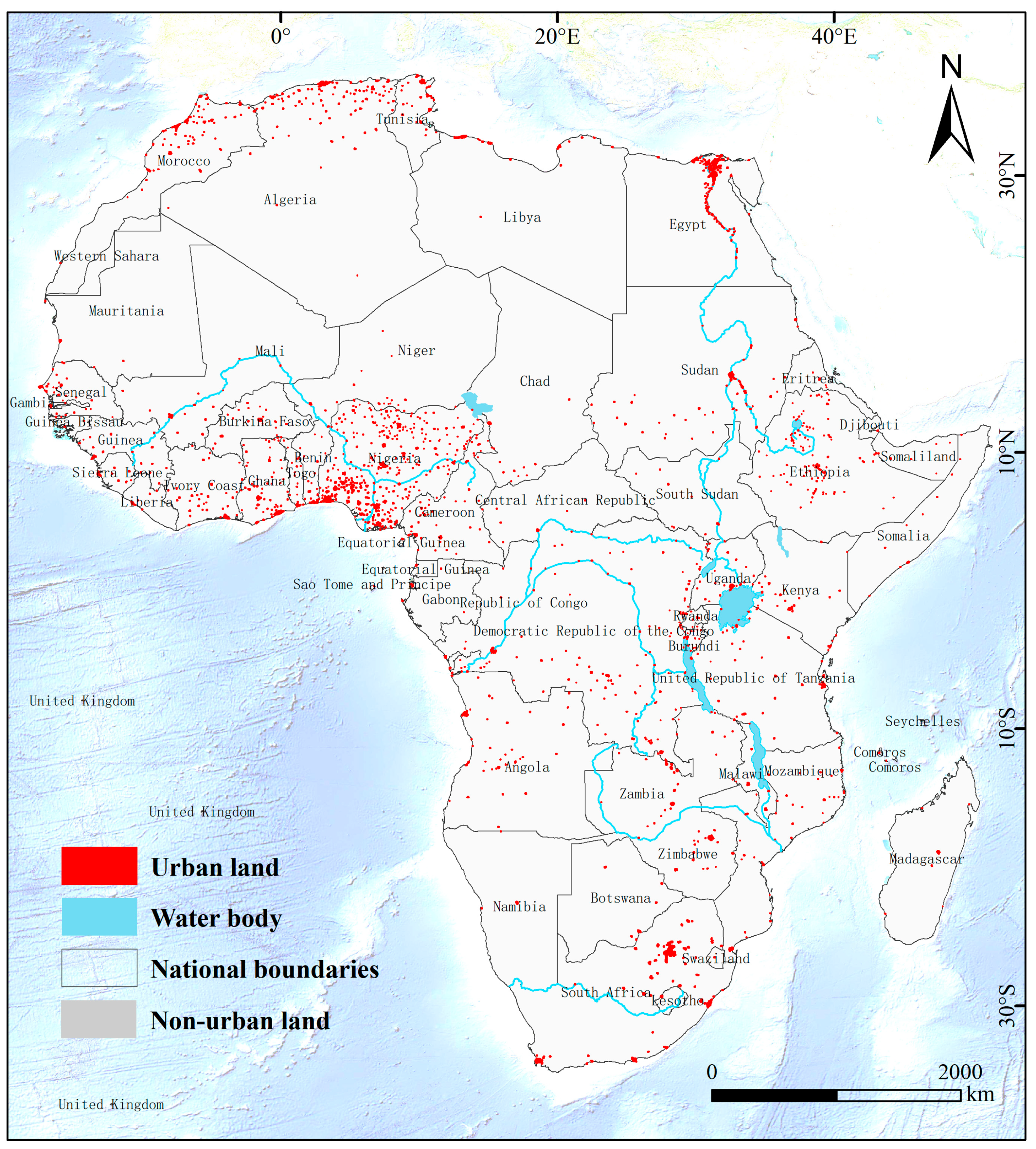
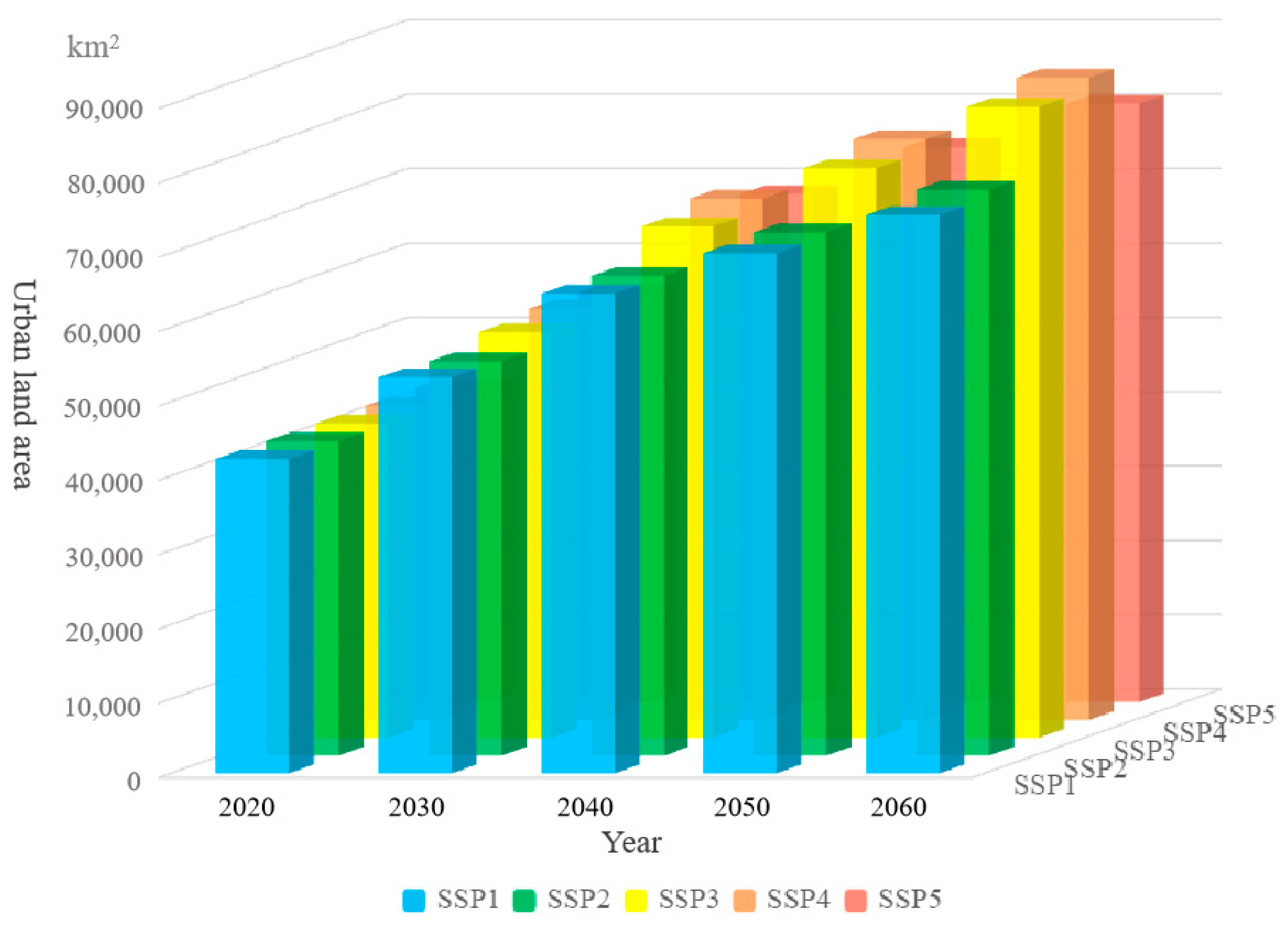
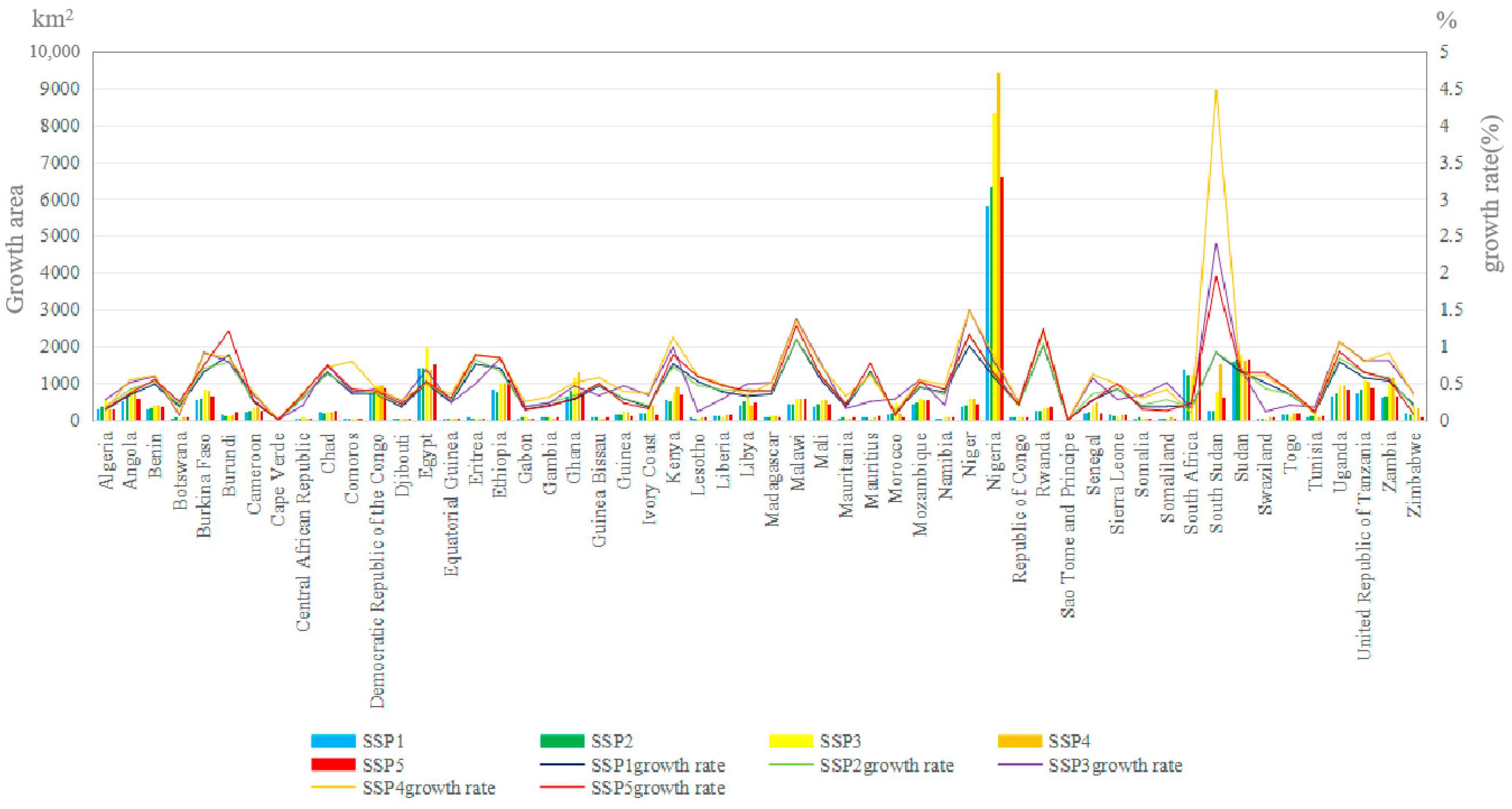
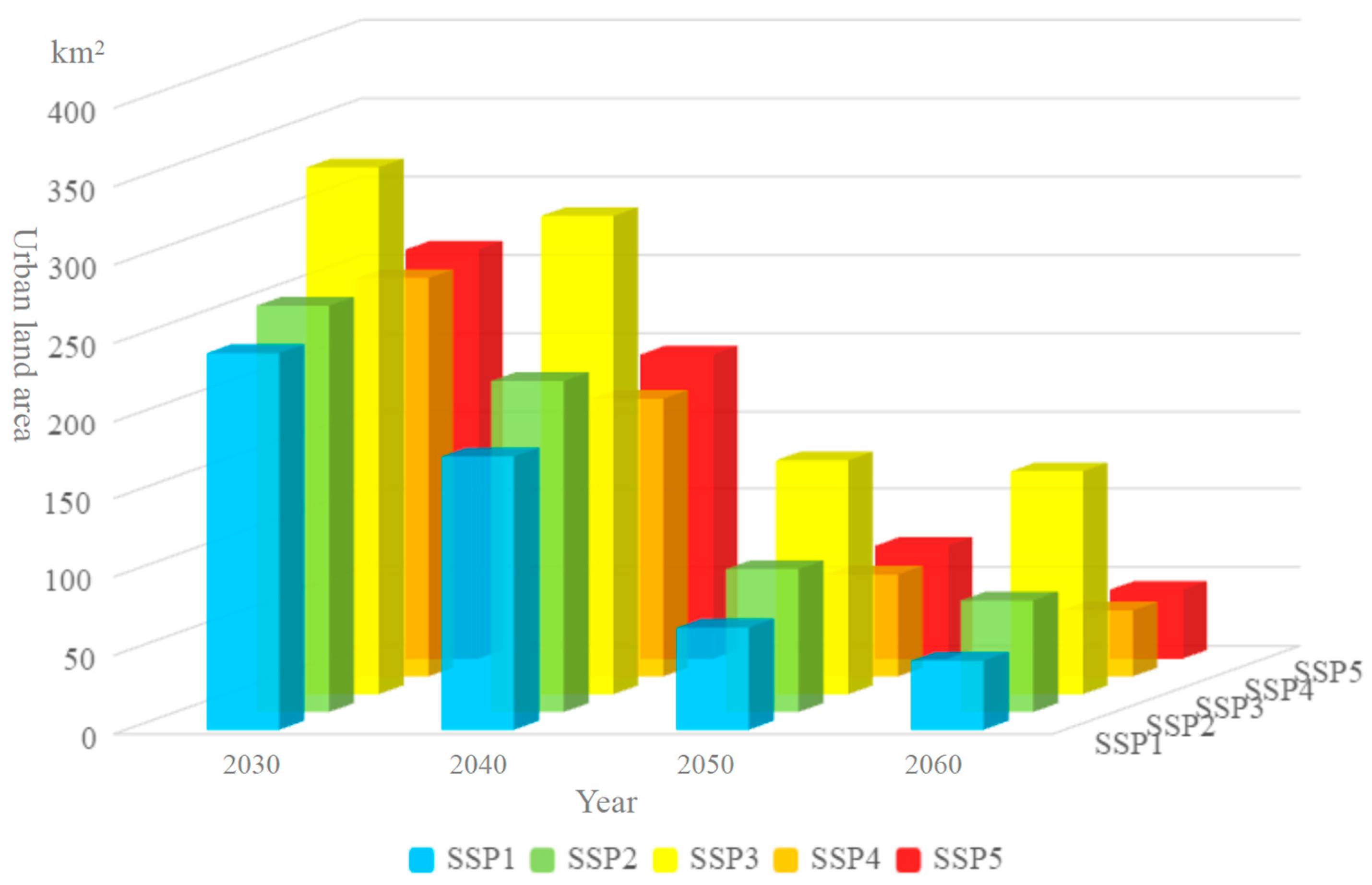


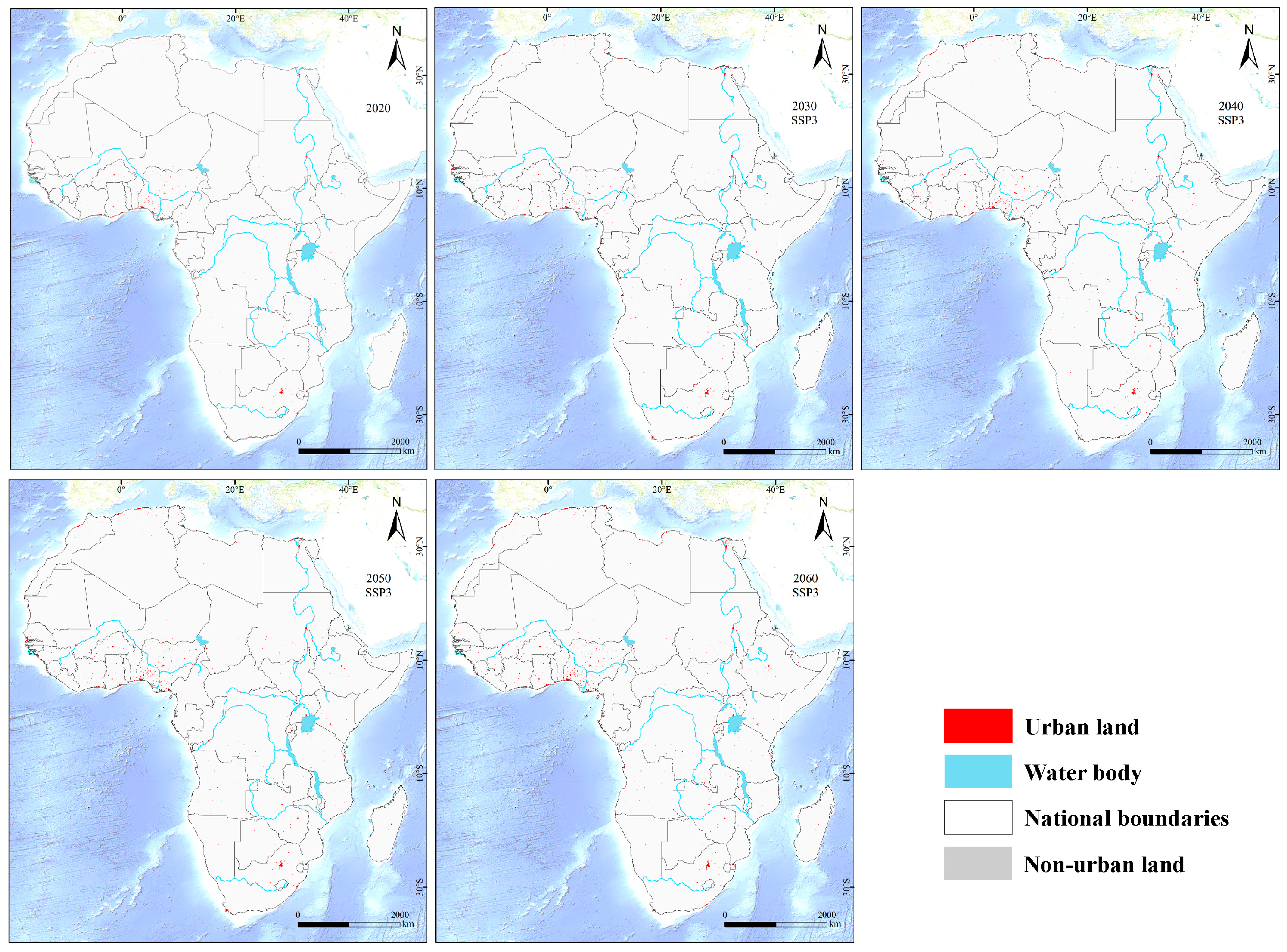

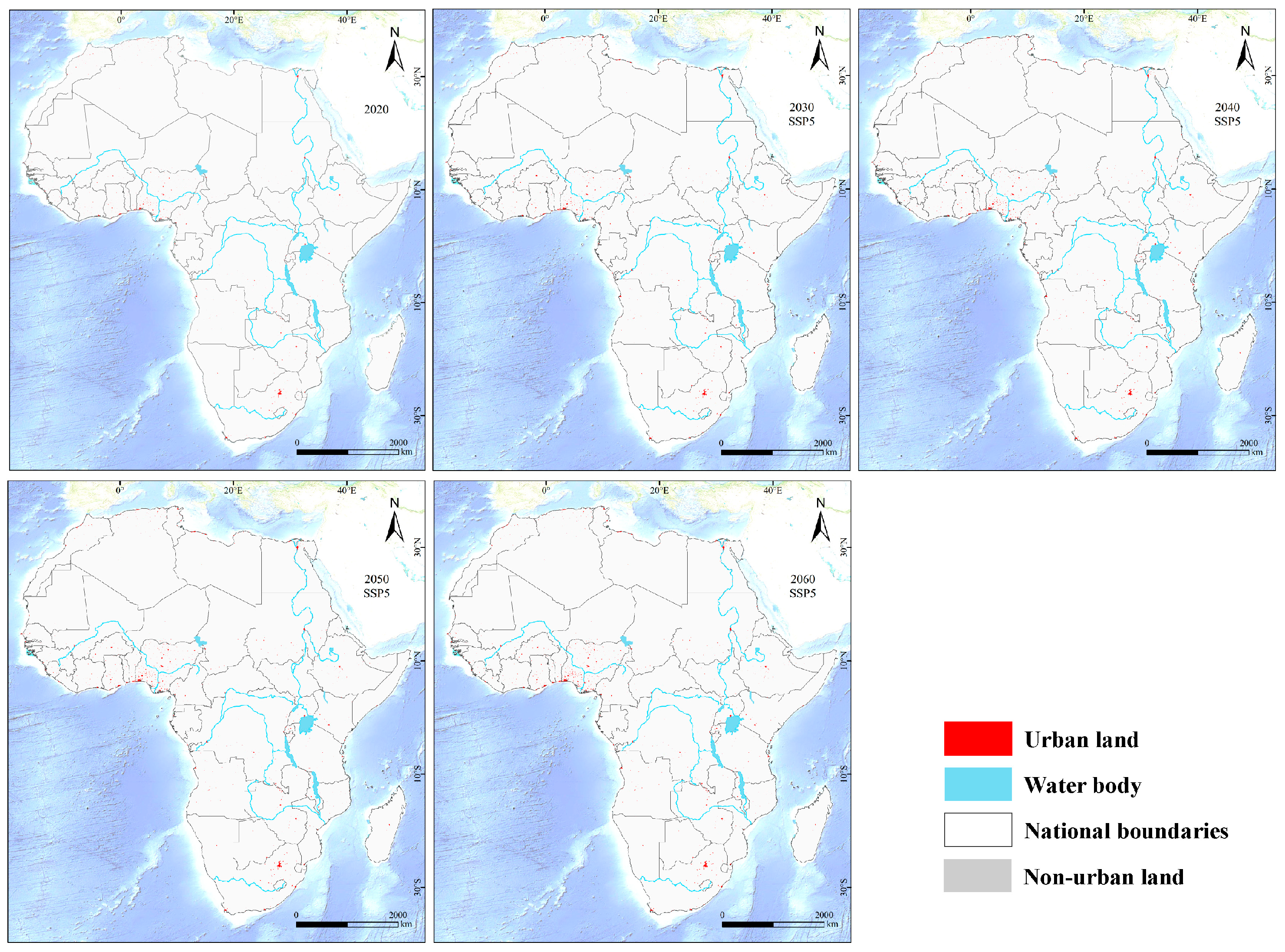
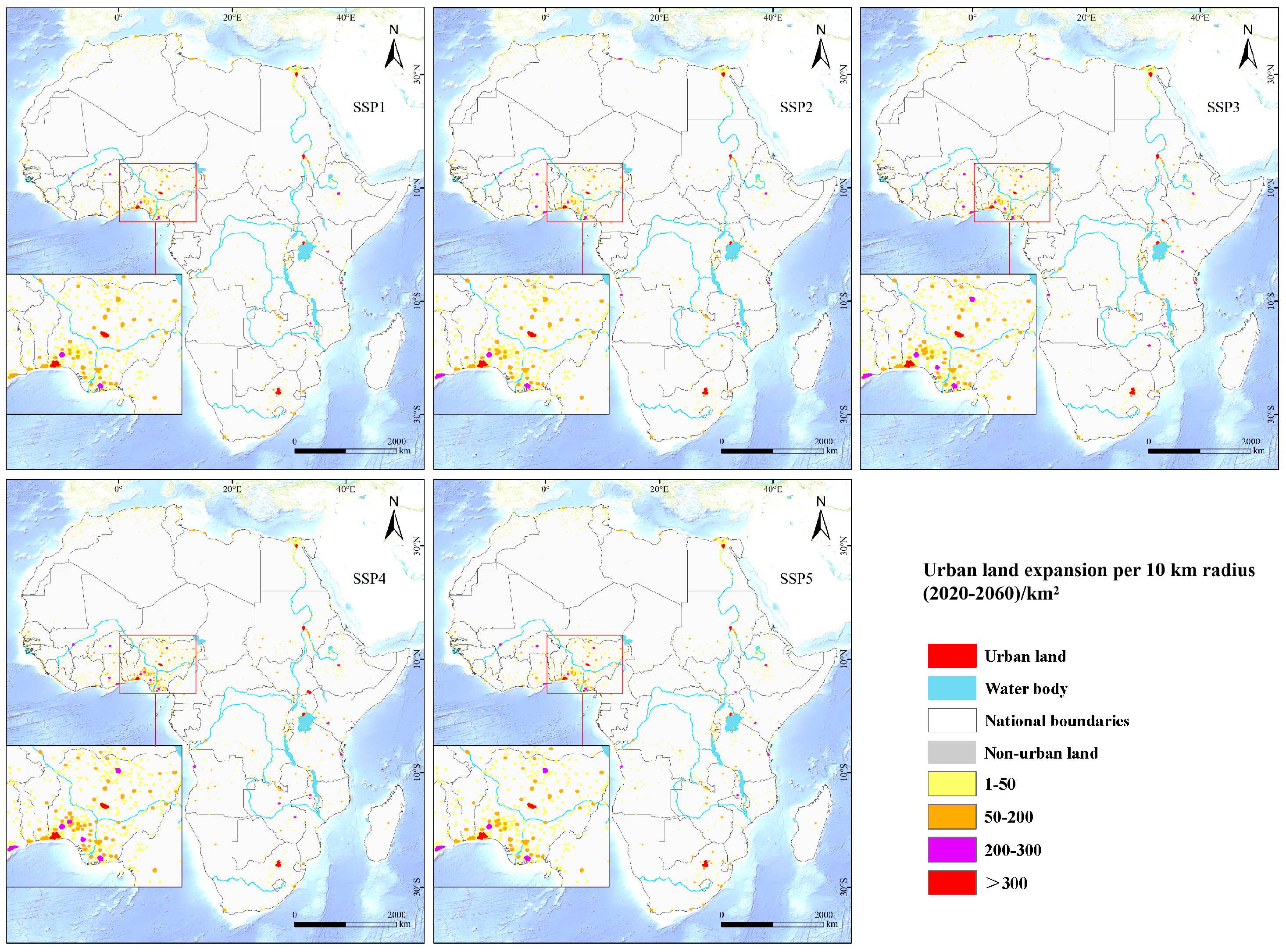

| Factor | Data | Years | Resolution | Data Source |
|---|---|---|---|---|
| Land Use (A) | Land use data (A1) | 2020 | 300 m | https://cds.climate.copernicus.eu/cdsapp#!/dataset/satellite-land-cover?tab=form (accessed on 15 January 2025) |
| Distance to Airport (A2) | 2015 | 1 km | HUANGZ, WU | |
| Social Factors (B) | Distance to road (B1) | 2020 | 1 km | NASA, Socioeconomic Data, and Applications Center |
| Distance to the administrative center (B2) | 2020 | 1 km | United Nations, Department of Economic and Social Affairs | |
| Distance to river (B3) | 2020 | 1 km | ESA-CCL (http://www.esa-landcover-cci.org/) (accessed on 16 January 2025) | |
| Economic factors (C) | Population Density (C1) | 2020 | 1 km | https://www.nature.com/articles/s41597-022-01675-x (accessed on 16 January 2025) |
| Global Human Impact Index (C2) | 2005 | 0.5′ | NASA, Socioeconomic Data, and Applications Center | |
| Night light data (C3) | 2020 | 1 km | National Oceanic and Atmospheric Administration (NOAA) | |
| Elevation (D1) | 2010 | 1 km | USGeological Survey (USGS), Globalmulti-resolution TerrainElevationData2010 (GmTED2010) | |
| Environmental factors (D) | Slope (D2) | 2010 | 1 km | |
| Slope aspect (D3) | 2010 | 1 km |
Disclaimer/Publisher’s Note: The statements, opinions and data contained in all publications are solely those of the individual author(s) and contributor(s) and not of MDPI and/or the editor(s). MDPI and/or the editor(s) disclaim responsibility for any injury to people or property resulting from any ideas, methods, instructions or products referred to in the content. |
© 2025 by the authors. Licensee MDPI, Basel, Switzerland. This article is an open access article distributed under the terms and conditions of the Creative Commons Attribution (CC BY) license (https://creativecommons.org/licenses/by/4.0/).
Share and Cite
Liu, B.; Xie, S.; Chen, M.; Yao, N.; Liu, W. Analysis of the Spatial Pattern of Urban Expansion in African Countries Under Different Shared Socioeconomic Pathway (SSP) Scenarios. Land 2025, 14, 558. https://doi.org/10.3390/land14030558
Liu B, Xie S, Chen M, Yao N, Liu W. Analysis of the Spatial Pattern of Urban Expansion in African Countries Under Different Shared Socioeconomic Pathway (SSP) Scenarios. Land. 2025; 14(3):558. https://doi.org/10.3390/land14030558
Chicago/Turabian StyleLiu, Binglin, Shuang Xie, Minru Chen, Nini Yao, and Weijiang Liu. 2025. "Analysis of the Spatial Pattern of Urban Expansion in African Countries Under Different Shared Socioeconomic Pathway (SSP) Scenarios" Land 14, no. 3: 558. https://doi.org/10.3390/land14030558
APA StyleLiu, B., Xie, S., Chen, M., Yao, N., & Liu, W. (2025). Analysis of the Spatial Pattern of Urban Expansion in African Countries Under Different Shared Socioeconomic Pathway (SSP) Scenarios. Land, 14(3), 558. https://doi.org/10.3390/land14030558









